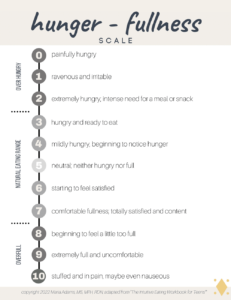Intuitive Eating for Addiction Recovery

Intuitive eating is a powerful way to bring mindfulness into your wellness journey, and can help those in recovery from addiction and mental health to feel more grounded, stable, and present.
The Basics of Intuitive Eating
Intuitive eating is a philosophy Developed by Evelyn Tribole and Elyse Resch in 1995. It that encourages individuals to develop a healthy relationship with food by listening to their body’s natural cues, rather than relying on external rules or restrictions.
It’s based on the premise that humans are born with innate wisdom about what and how much to eat, and that by tuning into these internal signals, one can achieve a balanced and sustainable approach to eating. The principles of intuitive eating include:
- Reject the diet mentality: Intuitive eating begins with letting go of the diet mentality, which involves restrictive eating patterns, food rules, and the pursuit of weight loss as the primary goal.
- Honor your hunger: This principle emphasizes the importance of tuning into your body’s hunger signals and responding to them appropriately by eating when you’re physically hungry. It encourages individuals to eat regularly and adequately to nourish their bodies.
- Make peace with food: Intuitive eating encourages unconditional permission to eat food without guilt or judgment. It involves letting go of the idea that certain foods are “good” or “bad” and allowing yourself to enjoy a wide variety of foods based on your preferences and cravings.
- Challenge the food police: This principle involves challenging the internalized voices or beliefs that dictate food choices based on morality or worthiness. It encourages individuals to develop a more compassionate and flexible attitude towards food and eating.
- Discover the satisfaction factor: Intuitive eating encourages mindful eating practices that focus on savoring and enjoying the eating experience. It involves paying attention to the taste, texture, and pleasure of food, as well as recognizing when you’re comfortably satisfied.
- Feel your fullness: This principle encourages individuals to listen to their body’s signals of fullness and stop eating when they’re satisfied, rather than relying on external cues or portion sizes dictated by diet rules.
- Cope with emotions without using food: Intuitive eating acknowledges the connection between emotions and eating but encourages finding alternative ways to cope with emotions without turning to food for comfort or distraction.
- Respect your body: This principle emphasizes self-acceptance and respect for your body, regardless of its size or shape. It involves practicing self-care and body positivity, as well as rejecting the societal pressure to conform to unrealistic beauty standards.
- Exercise for enjoyment: Intuitive eating promotes joyful movement that focuses on physical activity that feels good and energizing, rather than as a means to burn calories or change body shape.
- Honor your health with gentle nutrition: Finally, intuitive eating encourages making food choices that honor your health and taste buds, without strict rules or obsession over nutrient content. It involves prioritizing balanced eating patterns over perfection and allowing for flexibility and enjoyment in food choices.
Overall, intuitive eating is a holistic approach to nourishing your body and cultivating a positive relationship with food, based on self-awareness, self-compassion, and trust in your body’s innate wisdom.
The Hunger-Fullness Scale for Mental Health and Recovery

The Hunger-Fullness Scale is helpful for several reasons:
- Awareness: By tuning into your hunger and fullness levels, you become more aware of your body’s signals and can better understand your needs.
- Preventing Overeating: Using the scale can help you avoid overeating by stopping when you reach a comfortable level of fullness, rather than continuing to eat until you feel overly stuffed.
- Promoting Mindful Eating: It encourages mindful eating practices, where you pay attention to the sensory experiences of eating and honor your body’s signals rather than relying on external cues like portion sizes or calorie counts.
- Supporting Intuitive Eating: The Hunger-Fullness Scale aligns with the principles of intuitive eating, which emphasize eating in response to physical hunger and stopping when satisfied. This approach can lead to a healthier relationship with food and more sustainable eating habits.
This scale is not a set of rules to dictate when you should or shouldn’t eat. Rather, it can help you tune into your own body’s wisdom to tell you when it might be time to eat and also when you’re satisfied. It can also help you identify your eating patterns and what may be driving you to eat.
There will be times when you get overly hungry or when you eat past fullness and that’s OK. Tuning into your body’s needs is an ongoing process. Try to bring curiosity to these patterns and habits rather than judging them.
Here are some steps to get started:
- Familiarize Yourself with the Scale: Take some time to understand the different levels of the Hunger-Fullness Scale, from extreme hunger to extreme fullness. Visualize what each level feels like for you personally.
- Check-In with Your Hunger: Before eating, pause and assess your hunger level on a scale from 1 to 10. Ask yourself how hungry you are and try to identify the sensations in your body that indicate hunger, such as stomach growling or feeling weak.
- Eat Mindfully: When you start eating, pay attention to the sensory experience of eating. Notice the flavors, textures, and smells of your food. Chew slowly and savor each bite.
- Check-In During Eating: Throughout your meal, periodically pause to check in with your body. Notice how your hunger level is changing as you eat. Aim to stop eating when you reach a comfortable level of fullness, around a 7 on the scale.
- Listen to Your Body: Tune into your body’s signals and trust your instincts. If you’re still hungry after finishing your meal, it’s okay to eat more. Conversely, if you’re feeling satisfied or full before finishing your meal, it’s okay to stop eating, even if there’s food left on your plate.
- Reflect on Your Eating Experience: After eating, take a moment to reflect on how you feel physically and emotionally. Did you eat until you were satisfied, or did you overeat? Notice any patterns or habits that emerge as you practice using the Hunger-Fullness Scale.
- Practice Consistently: Using the Hunger-Fullness Scale is a skill that takes practice. Be patient with yourself as you learn to tune into your body’s cues and make adjustments to your eating habits accordingly.
Understanding Hunger
Different types of Hunger
Hunger can manifest in various forms beyond just the physical need for food. Here are some different types of hunger:
Physical Hunger: This is the most common type of hunger and occurs when your body needs nourishment. Physical hunger is typically accompanied by physical symptoms such as stomach growling, lightheadedness, irritability, and difficulty concentrating. It’s a signal that your body requires energy and nutrients.
Emotional Hunger: Emotional hunger is driven by emotions rather than physical cues. It’s often triggered by feelings such as stress, sadness, loneliness, or boredom. People experiencing emotional hunger may crave specific comfort foods or engage in mindless eating as a way to cope with their emotions. Unlike physical hunger, emotional hunger doesn’t necessarily arise from a physiological need for food.
Nutritional Hunger: This type of hunger arises when your body craves specific nutrients that may be lacking in your diet. For example, if you’re deficient in certain vitamins or minerals, your body may signal cravings for foods rich in those nutrients. Nutritional hunger can be addressed by consuming a balanced diet that meets your body’s nutritional requirements.
Sensory Hunger: Sensory hunger is driven by the desire for sensory stimulation rather than physiological need. It can be triggered by the sight, smell, or taste of food, even when you’re not physically hungry. For example, seeing a commercial for pizza or smelling freshly baked cookies might stimulate sensory hunger and lead to cravings.
Environmental Hunger: Environmental factors such as social situations, cultural influences, and food availability can also influence hunger. For instance, being in a social setting where others are eating can stimulate hunger cues even if you’re not physically hungry. Similarly, exposure to food advertisements or being surrounded by tempting food options can trigger hunger signals.
Practical Hunger: This type of hunger is driven by practical considerations rather than immediate physiological cues. It occurs when you anticipate being hungry in the near future and decide to eat preemptively to avoid discomfort later. Practical hunger may arise in situations where you know you’ll be busy and won’t have time to eat later, or when you anticipate limited access to food. For example, packing a snack for a long journey or eating before a meeting that is expected to run through lunchtime. While practical hunger isn’t necessarily driven by immediate physical cues, it is a proactive approach to meeting your body’s needs and maintaining energy levels throughout the day.
Recognizing Fullness
Your first sign that you are full usually shows up as a physical feeling in the stomach. Fullness cues can also include food not tasting as good as it initially did when you were truly hungry.
If you are haven’t been eating to fullness due to dieting, distraction, substance use, or simply being disconnected from your cues, eating until you’re truly full may actually feel even a little uncomfortable (because you’re used to living in that neutral zone). Start to notice how long a meal keeps you full. Meals should keep you full for at least 3 hours. If not, you probably didn’t eat enough
On the other hand, your past experience of fullness may only be feeling overstuffed. Practice checking in with your body throughout the meal. If you overeat or under-eat, that is part of the process of learning your own body’s cues. Be gentle and nonjudgmental with yourself.
Intuitive Eating to Aid in Addiction Recovery
Overall, developing a mindful relationship with food by practicing intuitive eating can be a powerful piece in achieving holistic recovery from addiction and mental health issues. To learn more about how we incorporate this and other components of nutrition into our treatment programming, call us for a no-cost consultation.

